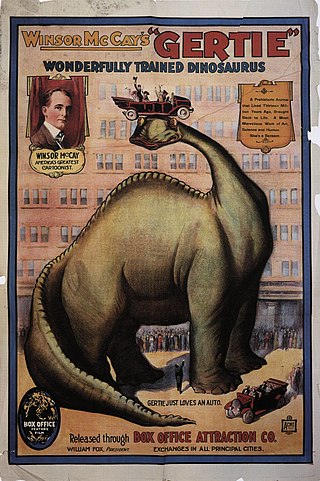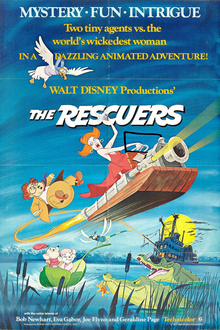Career
While studying for his bachelor of arts degree, Canemaker's childhood interest in animation revived. He began making sponsored animated shorts and wrote the first of more than 100 articles on animation history. His first book, the story of the making of Richard Williams' Raggedy Ann and Andy , was published in 1977 as The Animated Raggedy Ann and Andy. In 1982, he wrote the introduction of Treasures of Disney Animation Art; in 1987, he published Winsor McCay—His Life and Art; and, in 1991, Felix, the Twisted Tale of the World's Most Famous Cat. There followed Tex Avery: The MGM Years and Before the Animation Begins: the Art and Lives of Disney Inspirational Sketch Artists (both in 1997), Paper Dreams: The Art and Artists of Disney Storyboards (1999), Walt Disney's Nine Old Men and the Art of Animation (2001), and The Art and Flair of Mary Blair (2003).
His research in the history of animation inspired two of his own films, Remembering Winsor McCay (1976) and Otto Messmer and Felix the Cat (1977).
Canemaker's filmography includes independently made animated shorts that are part of the permanent collection of New York's Museum of Modern Art. Among them are The '40s (1974), Street Freaks (1975), Confessions of a Stardreamer (1978), The Wizard's Son (1981), Bottom's Dream (1983), Confessions of a Stand-Up (1993), and Bridgehampton (1998).
In the early 1980s, Canemaker animated several Children's Television Workshop films for Sesame Street , TV commercials, and, in 1981, created the animation sequences for the Warner Bros. feature The World According to Garp . He designed and directed animation sequences in the Academy Award-winning HBO documentary You Don't Have to Die (1988) and the Peabody Award-winning CBS documentary Break the Silence: Kids Against Child Abuse (1994).
John Canemaker: Marching to a Different Toon, a DVD/home video collection of his films, is distributed by Milestone Film & Video/Image Entertainment. In addition, Canemaker writes regularly on animation for The New York Times and is on-camera and audio commentator on DVD versions of The Fantasia Anthology, Dumbo , Beauty and the Beast , Peter Pan , Snow White and the Seven Dwarfs , Cut-up: The Films of Grant Munro , and Winsor McCay: The Master Edition. He has appeared on NBC's Today , PBS' The NewsHour with Jim Lehrer , and Entertainment Tonight , and has lectured throughout the United States and in Brazil, Canada, England, Ireland, France, Germany, Italy, Japan, Slovakia, Spain, Switzerland, and Wales.
In 2006, he received an Award for outstanding contribution to animation studies at the World Festival of Animated Film - Animafest Zagreb.

Gertie the Dinosaur is a 1914 animated short film by American cartoonist and animator Winsor McCay. It is the earliest animated film to feature a dinosaur. McCay first used the film before live audiences as an interactive part of his vaudeville act; the frisky, childlike Gertie did tricks at the command of her master. McCay's employer William Randolph Hearst curtailed McCay's vaudeville activities, so McCay added a live-action introductory sequence to the film for its theatrical release renamed Winsor McCay, the Famous Cartoonist, and Gertie. McCay abandoned a sequel, Gertie on Tour, after producing about a minute of footage.

Zenas Winsor McCay was an American cartoonist and animator. He is best known for the comic strip Little Nemo and the animated film Gertie the Dinosaur (1914). For contractual reasons, he worked under the pen name Silas on the comic strip Dream of the Rarebit Fiend.

The Rescuers is a 1977 American animated adventure comedy-drama film produced by Walt Disney Productions and released by Buena Vista Distribution. It is the 23rd Disney animated feature film. Bob Newhart and Eva Gabor respectively star as Bernard and Bianca, two mice who are members of the Rescue Aid Society, an international mouse organization dedicated to helping abduction victims around the world. Both must free young orphan Penny from two treasure hunters, who intend to use her to help them obtain a giant diamond. The film is based on a series of books by Margery Sharp, including The Rescuers (1959) and Miss Bianca (1962).

Marc Fraser Davis was a prominent American artist and animator for Walt Disney Animation Studios. He was one of Disney's Nine Old Men, the famed core animators of Disney animated films, and was revered for his knowledge and understanding of visual aesthetics. After his work on One Hundred and One Dalmatians he moved to Walt Disney Imagineering to work on rides for Disneyland and Walt Disney World before retiring in 1978.

Andreas Deja is a Polish-born German-American character animator, most noted for his work at Walt Disney Animation Studios. Deja's work includes serving as supervising animator on characters in several Disney animated films, including the Disney villains Gaston in Beauty and the Beast, Jafar in Aladdin, and Scar in The Lion King, the titular character in Hercules, and Lilo Pelekai in Lilo & Stitch.
Robert Fred Moore, was an American artist and animator for Walt Disney Animation Studios. Often called "Freddie," he was born and raised in Los Angeles, California. Despite limited formal art training, he rose to prominence at Disney very quickly in the early 1930s, due to his great natural talent and the tremendous appeal of his drawings. His drawings are still greatly admired by animators and animation fans.

Wolfgang Reitherman, also known and sometimes credited as Woolie Reitherman, was a German–American animator, director and producer and one of the "Nine Old Men" of core animators at Walt Disney Productions. He emerged as a key figure at Disney during the 1960s and 1970s, a transitionary period which saw the death of Walt Disney in 1966, with him serving as director and/or producer on eight consecutive Disney animated feature films from One Hundred and One Dalmatians through The Fox and the Hound.
Joseph C. Grant was an American artist and writer.

Mary Blair was an American artist, animator, and designer. She was prominent in producing art and animation for The Walt Disney Company, drawing concept art for such films as Alice in Wonderland, Peter Pan, Song of the South and Cinderella. Blair also created character designs for enduring attractions such as Disneyland's It's a Small World, the fiesta scene in El Rio del Tiempo in the Mexico pavilion in Epcot's World Showcase, and an enormous mosaic inside Disney's Contemporary Resort. Several of her illustrated children's books from the 1950s remain in print, such as I Can Fly by Ruth Krauss. Blair was inducted into the group of Disney Legends in 1991.

Eric Allen Goldberg is an American animator, voice actor and film director known for his work at both Walt Disney Animation Studios and Warner Bros. Animation.

Floyd E. Norman is an American animator, writer, and cartoonist. Over the course of his career, Norman has worked for various animation companies, among them Walt Disney Animation Studios, Hanna-Barbera Productions, Ruby-Spears, Film Roman and Pixar.

Milton Erwin Kahl was an American animator. He was one of Walt Disney's supervisory team of animators, known as Disney's Nine Old Men.
"The Story of the Animated Drawing" is an episode of the Walt Disney's Disneyland television program originally broadcast on November 30, 1955.

The Sinking of the Lusitania (1918) is an American silent animated short film by cartoonist Winsor McCay. It is a work of propaganda re-creating the never-photographed 1915 sinking of the British liner RMS Lusitania. At twelve minutes it has been called the longest work of animation at the time of its release. The film is the earliest surviving animated documentary and serious, dramatic work of animation. The National Film Registry selected it for preservation in 2017.

Kenneth B. Anderson was an American art director and a writer at Walt Disney Animation Studios for 44 years.
Richard Huemer was an American animator in the Golden Age of Animation.
Emery Otis Hawkins was an American animator, best known for his work during the Golden age of American animation, working in various studios in the industry.

How a Mosquito Operates is a 1912 silent animated film by American cartoonist Winsor McCay. The six-minute short depicts a giant mosquito tormenting a sleeping man. The film is one of the earliest works of animation, and its technical quality is considered far ahead of its time. It is also known under the titles The Story of a Mosquito and Winsor McCay and his Jersey Skeeters.

Tom Sito is an American animator, animation historian and teacher. He is currently a Professor at USC's School of Cinematic Arts in the Animation Division. In 1998, Sito was included by Animation Magazine in their list of the One Hundred Most Important People in Animation.

Disney's Nine Old Men were Walt Disney Productions' core animators, some of whom later became directors, who created some of Disney's most popular animated movies from Snow White and the Seven Dwarfs to The Rescuers, and were referred to as such by Walt Disney himself. They worked in both short and feature films. Disney delegated more and more tasks to them in the animation department in the 1950s when their interests expanded, and diversified their scope. Eric Larson was the last to retire from Disney, after his role as animation consultant on The Great Mouse Detective in 1986. All nine members of the group were acknowledged as Disney Legends in 1989.














